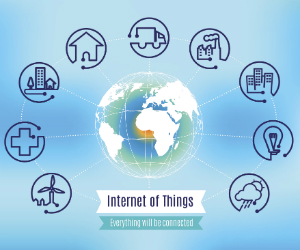Big-data systems are used to process and analyze the vast amounts of information generated by various sensors in the modern smart building. Their success in doing so is bound to drive cost savings and also change the way we work, however widespread adoption is still far.
In 2015, the Amsterdam headquarters building of consulting firm Deloitte was voted the “World’s Smartest Building.” The building, fittingly named “The Edge” it is an example how the use of sensors, big data and connectivity changes the way companies manage office buildings. The Edge is also the greenest building in the world. The British rating agency BREEAM, gave it the highest sustainability score ever awarded: 98.36 percent. In addition, The Edge is most probably the most connected building in the world, 28 thousand sensors: motion, light, temperature, humidity, and infrared are laced in and around the building and collect, track and analyze data.
“The core of IoT is ambient intelligence – systems that focus on people and their experience.”
- Rob Martens, Futurist and Director of Connectivity Platforms, Allegion
LPR cameras recognize entering vehicles and direct them to vacant parking places. 2500 workers are assigned work places based on their daily schedule in a system called “hot-desk,” this means that instead of having empty unmanned desks during the day when employees are in meetings or out of the office, the system allocates work stations (conference rooms, desks, etc.) based on workers needs and preference. Using this system, Deloitte managed to cut the number of desks in the building by almost half. In addition, when many people are out of office, the building management can choose to close off parts of the building and save utility costs on lighting, heating and cooling and cleaning.
The opposite is also true. Sensors also tell the building management which areas need cleaning first, areas that were in use more during the day will be the first on the list of the cleaning crew. At night, office security is managed by a small robot patrolling the grounds. Equipped with cameras, it can transmit video to a security control post and let human operators decide if an alarm is false or not.
 Smart buildings have a lot of potential for
Smart buildings have a lot of potential for
the Internet of Things (IoT).
“The premise of IoT is that billions of devices will communicate with each other and benefit us,” explained Rob Martens, Futurist and Director of Connectivity Platforms at Allegion during a speech given at ISC West trade show in 2015. “The core of IoT is ambient intelligence – systems that focus on people and their experience.”
“There are several types of sensors: embedded sensors, context aware sensors (i.e. sensors that understand the activity and environment the user is in), personalized, adaptive (sensor who react to what happens in the environment) and anticipatory sensors, anticipating user intentions. The number of connected devices is staggering. A thoughtful combination of some or all these sensors gives a more personalized experience and this is the upcoming expectation of users,” added Martens.
Sensors are only one part of the solution. There is a need for sophisticated software with massive computing power that will deliver the efficiencies and benefits of IoT. This is where big data steps in. Using big data software, information can be analyzed and action can be taken immediately to optimize the building. In addition, with tools such as anomaly detection analytics, building managers can identify problems as they happen, or even before they happen.
“Furthermore, big data and machine learning allows a building to actively participate in future, co-operative smart grid systems which will ease the introduction of more renewable sources of energy whilst increasing the robustness of the underlying energy infrastructure.”
- Peter Dickinson, CTO, BuildingIQ
A report published by Memoori Business Intelligence titled “Big Data for Smart Buildings – Market Prospects 2015 to 2020” states that the market for big data and cloud-based software services is still nascent and in 2014 was US$5.2 billion. The market is projected to show impressive growth to $9.17 billion in 2015 and at a rate of 33.2% CAGR to nearly $30 billion by 2020.
“From our perspective, we see big data being used to drive machine learning applications. These advanced artificial intelligence technologies provide for a more dynamic and responsive building that is more ‘aware’ of the strategic goals of the building owner and operator. For example, it can balance and optimize different complex demands: plant efficiency, dynamic energy pricing and occupant comfort. Furthermore, big data and machine learning allows a building to actively participate in future, cooperative smart grid systems which will ease the introduction of more renewable sources of energy whilst increasing the robustness of the underlying energy infrastructure,” explained Peter Dickinson, CTO of Australian-based BuildingIQ.
As the sensors and data systems are established within smart buildings, customers will gradually realize they need to move beyond simple reporting and dashboards. “Despite the strategic value of providing real-time information to operators, the greatest opportunity that we see is in solutions that take the most difficult step of converting the data into dynamic, responsive ‘closed loop’ control systems,” said Dickinson. However, in the near to mid-term future systems will still rely on the combination of human operators and machines.